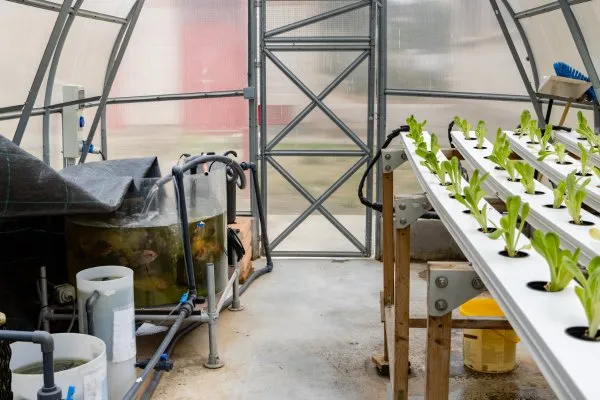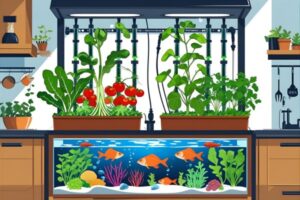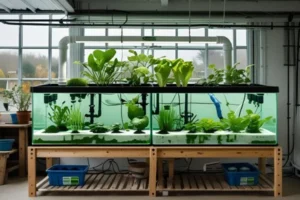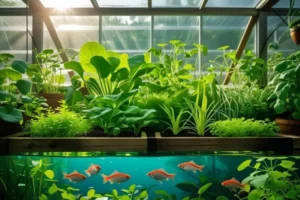Did you know that traditional agriculture consumes 70% of global freshwater resources while feeding only 60% of the world’s population efficiently? With climate change intensifying droughts and soil degradation affecting 33% of arable land worldwide, our conventional farming methods are reaching a breaking point.
Traditional agriculture faces mounting challenges: excessive water usage, chemical fertilizer dependency, soil erosion, and increasing production costs. These methods often require vast amounts of land, contribute to environmental pollution through pesticide runoff, and struggle to provide consistent yields in urban environments where food security is most critical.
But what if there was a farming method that could produce both fresh fish and vegetables using 90% less water than traditional agriculture, require no soil, eliminate the need for chemical fertilizers, and work in virtually any climate or location?
Enter aquaponics – a revolutionary sustainable farming technique that’s transforming how we think about food production. In this comprehensive guide, you’ll discover exactly what aquaponics is, how this ingenious system works by mimicking natural ecosystems, and why it’s considered the future of sustainable agriculture. Whether you’re a curious beginner or considering starting your own system, you’ll learn everything needed to understand and potentially implement this game-changing technology.
What is Aquaponics? The Simple Definition
Aquaponics is a sustainable food production system that combines aquaculture (raising fish) with hydroponics (growing plants in water) in a symbiotic environment. This innovative farming method creates a closed-loop ecosystem where fish and plants work together to support each other’s growth, mimicking natural processes found in rivers, lakes, and wetlands.
At its core, aquaponics operates on a beautifully simple principle: fish waste becomes plant food, and plants clean the water for the fish. This natural partnership eliminates the need for chemical fertilizers while creating two valuable food sources simultaneously – fresh fish and organic vegetables.
The system revolves around three essential living components working in perfect harmony:
Fish serve as the foundation of the system, producing nutrient-rich waste through their natural biological processes. Popular species include tilapia, trout, catfish, and ornamental fish like goldfish for smaller systems. These fish require minimal care while providing continuous fertilizer production.
Plants act as natural water filters, absorbing nutrients from fish waste to fuel their growth. Leafy greens like lettuce, spinach, and herbs thrive in aquaponic systems, though fruiting plants like tomatoes and peppers can also flourish with proper system design.
Beneficial bacteria are the invisible heroes that make the magic happen. These microscopic organisms convert toxic ammonia from fish waste into nitrites, then into nitrates – the perfect plant fertilizer. This process, called the nitrogen cycle, is the biological engine that powers every successful aquaponics system.
Unlike traditional farming that requires soil, chemical fertilizers, and extensive water resources, aquaponics creates a self-sustaining ecosystem that produces food year-round with minimal external inputs. The result is faster plant growth, healthier fish, and significantly reduced environmental impact compared to conventional agriculture methods.
How Does Aquaponics Work? The Science Behind It
Understanding the science behind aquaponics reveals why this system is so remarkably effective. The entire process centers around the nitrogen cycle – nature’s own recycling system that transforms waste into valuable nutrients.
The Nitrogen Cycle Explained
The nitrogen cycle is the biological heart of aquaponics. Fish excrete ammonia (NH₃) through their gills and waste, which is highly toxic to aquatic life in concentrated amounts. Beneficial bacteria called Nitrosomonas convert this ammonia into nitrites (NO₂⁻), while another bacterial species, Nitrobacter, transforms nitrites into nitrates (NO₃⁻). Nitrates are the perfect plant fertilizer – readily absorbed by roots to fuel rapid growth. This natural process typically takes 4-6 weeks to establish in new systems.
The Three Main Components
The fish tank houses your aquatic livestock and serves as the nutrient generation center. Fish consume protein-rich food and produce ammonia-laden waste that fuels the entire system. The grow beds contain plants and growing medium where beneficial bacteria colonize, creating the biological filter that processes fish waste. The water pump and plumbing system ensures continuous circulation, delivering oxygenated, nutrient-rich water to plants while returning clean water to fish.
Water Flow and System Balance
Water circulation is critical for system success. Continuous flow ensures adequate oxygen levels for fish while delivering fresh nutrients to plants. Most systems maintain a flow rate of 1-3 times the fish tank volume per hour. The water picks up ammonia from the fish tank, gets processed by bacteria in the grow beds, and returns purified to the fish tank. This creates a perfectly balanced ecosystem where waste becomes food, and plants become living water filters.
Types of Aquaponics Systems
Choosing the right aquaponics system depends on your space, budget, and growing goals. Each system type offers unique advantages for different applications, from small home setups to commercial operations.
Deep Water Culture (DWC)
Deep Water Culture suspends plant roots directly in nutrient-rich water with constant aeration. Plants sit in floating rafts with roots dangling into water channels typically 6-12 inches deep. This method excels for leafy greens like lettuce, spinach, and herbs, producing rapid growth rates due to constant nutrient access. DWC systems are popular in commercial operations because they’re simple to maintain and offer excellent space efficiency. However, they require reliable power for air pumps and work best for lighter plants that don’t need root support.
Nutrient Film Technique (NFT)
NFT systems use sloped channels or tubes where a thin film of nutrient water flows continuously past plant roots. Plants are typically placed in small pots with growing medium, allowing roots to extend into the water flow. This method provides excellent oxygen exposure while conserving water. NFT works perfectly for herbs, strawberries, and smaller leafy greens but struggles with larger plants due to limited root space and support.
Media Bed Systems
Media bed systems use inert growing medium like expanded clay pebbles, gravel, or lava rock to support plants while providing biological filtration. Water floods and drains from beds using bell siphons or timed pumps, creating wet/dry cycles that benefit both plants and bacteria. This versatile method supports everything from lettuce to tomatoes and provides excellent biological filtration, making it ideal for beginners.
Hybrid Systems
Hybrid systems combine multiple techniques to maximize benefits. Common combinations include media beds for biological filtration with DWC rafts for production, or NFT channels fed by media bed-filtered water. These systems offer greater flexibility and can accommodate diverse plant types while optimizing space utilization.
Benefits of Aquaponics vs Traditional Farming
Aquaponics offers compelling advantages over conventional agriculture, making it an increasingly attractive option for sustainable food production. These benefits extend from environmental conservation to economic efficiency.
Water Conservation
Aquaponics uses 90% less water than traditional soil farming through its closed-loop recirculation system. While conventional agriculture loses water through soil absorption, evaporation, and runoff, aquaponics continuously recycles the same water. A typical aquaponics system only requires water additions to replace evaporation and transpiration losses. For perspective, producing 1 pound of lettuce requires approximately 250 gallons in traditional farming versus just 25 gallons in aquaponics.
No Soil Needed
Soil-free production eliminates concerns about soil quality, contamination, or depletion. This advantage is crucial in urban environments, areas with poor soil conditions, or regions facing soil erosion. Plants receive nutrients directly through water, often resulting in faster growth rates and cleaner harvests without soil-borne pests or diseases.
Organic Production
Aquaponics naturally produces organic food without synthetic fertilizers or pesticides. The closed system prevents chemical contamination, while beneficial bacteria and natural plant defenses manage most pest issues. Fish waste provides 100% natural fertilization, creating products that often exceed organic certification standards.
Higher Yields
Space efficiency in aquaponics can produce 3-4 times more vegetables per square foot than traditional farming. Vertical growing systems and year-round production cycles maximize output. The controlled environment eliminates weather-related crop losses while optimized nutrient delivery accelerates plant growth cycles.
Year-Round Growing
Climate-controlled systems enable continuous production regardless of external weather conditions. This stability provides consistent harvests, reliable income for commercial growers, and food security for families. Indoor systems protect crops from droughts, floods, extreme temperatures, and seasonal limitations that plague traditional outdoor farming.
Best Fish and Plants for Aquaponics
Selecting compatible fish and plants is crucial for aquaponics success. The right combinations ensure optimal nutrient production, system balance, and maximum yields for your specific climate and goals.
Popular Fish Species
Tilapia remains the gold standard for aquaponics due to their hardy nature, rapid growth, and excellent waste production. They tolerate temperature fluctuations (60-85°F), reproduce easily, and reach harvest size in 6-8 months. Trout excel in cooler climates, preferring temperatures between 50-65°F, and offer premium market value despite requiring higher oxygen levels.
Channel catfish are extremely hardy and tolerate poor water conditions, making them perfect for beginners. They grow well in temperatures from 70-85°F and provide excellent eating quality. For ornamental systems or colder climates, goldfish and koi work wonderfully, though they’re not typically harvested for food.
Largemouth bass offer exciting possibilities for sport fish production, while bluegill provide fast reproduction and good waste production for smaller systems.
Ideal Plants for Beginners
Leafy greens are aquaponics superstars, thriving in the nutrient-rich environment. Lettuce varieties (buttercrunch, romaine, red leaf) grow rapidly and tolerate varying nutrient levels. Spinach, kale, and Swiss chard provide excellent nutrition and consistent harvests.
Herbs like basil, cilantro, parsley, and mint command premium prices and grow exceptionally well in aquaponics systems. Fruiting plants including tomatoes, peppers, cucumbers, and strawberries require more mature systems with higher nutrient levels but offer greater yields and market value.
Compatibility Considerations
Temperature matching is essential – warm-water fish like tilapia pair well with heat-loving plants like basil and tomatoes, while trout systems support cool-season crops like lettuce and spinach. System maturity matters too; new systems support leafy greens best, while established systems (3+ months old) can handle nutrient-hungry fruiting plants. pH preferences should align, with most fish and plants thriving in the 6.8-7.2 range.
Getting Started: Your First Aquaponics System
Starting your aquaponics journey requires careful planning and realistic expectations. Success begins with choosing the right system size and understanding essential components before making your first investment.
Small-Scale vs Commercial Options
Desktop systems holding 10 to 20 gallons are perfect for learning basics and growing herbs on countertops. These starter kits cost between 50 USD and 200 USD, helping beginners understand system dynamics without major investment. Backyard systems containing 100 to 500 gallons can feed a family of four with fresh vegetables and occasional fish harvests. These intermediate systems typically cost 500 USD to 2,000 USD and fit in garages, basements, or small yards.
Commercial operations requiring 1,000 gallons or more demand significant investment ranging from 10,000 USD to 100,000 USD or higher, but can generate substantial income through farmers markets, restaurants, or CSA programs. Commercial success demands business planning, market research, and often greenhouse facilities for year-round production.
Essential Equipment and Materials
Core components include fish tanks, grow beds, water pumps, air pumps, and plumbing connections. Fish tanks should hold a minimum of 50 gallons for stable water conditions. Grow beds typically maintain a 1:1 or 2:1 ratio to fish tank volume. Water pumps must cycle the entire tank volume every 1 to 2 hours.
Growing medium options include expanded clay pebbles costing 25 USD to 40 USD per cubic foot, gravel at 20 USD to 30 USD per cubic foot, or lava rock. Water testing kits for pH, ammonia, nitrite, and nitrate are essential, costing 30 USD to 60 USD. Backup power or battery-powered air pumps prevent fish kills during power outages.
Budget Considerations
Startup costs for basic backyard systems range from 500 USD to 1,500 USD, including tanks, pumps, grow beds, and initial fish and plants. Monthly operating costs include fish food at 20 USD to 50 USD per month, electricity bills of 15 USD to 40 USD per month, and occasional plant seeds. Payback periods typically span 6 to 18 months through reduced grocery bills and potential surplus sales.
Hidden costs include water testing supplies, backup equipment, heating and cooling systems, and system upgrades as experience grows.
Common Challenges and Solutions
Every aquaponics system faces challenges, but understanding common problems and their solutions helps ensure long-term success. Most issues stem from water quality imbalances, inadequate system cycling, or poor maintenance practices.
Water Quality Issues
High ammonia levels above 1.0 ppm indicate overfeeding or insufficient biological filtration. Solution: Reduce feeding by 50 percent for 3 to 5 days, increase aeration, and test daily until ammonia drops below 0.5 ppm. pH fluctuations outside the ideal range of 6.8 to 7.2 stress both fish and plants. Solution: Add crushed coral or limestone to raise pH gradually, or use phosphoric acid to lower pH by 0.2 units per day maximum.
Cloudy water typically results from bacterial blooms or suspended particles. Solution: Increase mechanical filtration, reduce feeding for 2 to 3 days, and ensure adequate water circulation of 1 to 3 times tank volume per hour.
Fish Health Problems
Fish gasping at surface indicates low dissolved oxygen below 4.0 ppm. Solution: Immediately increase aeration, check for dead fish, and reduce feeding until oxygen levels stabilize above 5.0 ppm. Fish diseases like ich or fin rot spread quickly in stressed populations. Solution: Quarantine new fish for 14 days, maintain stable temperatures within 2 degrees Fahrenheit of target range, and avoid overcrowding beyond 1 pound of fish per 5 to 10 gallons of water.
Plant Nutrient Deficiencies
Iron deficiency shows as yellowing leaves with green veins. Solution: Add chelated iron at 1 to 2 ppm weekly until symptoms resolve. Potassium deficiency causes brown leaf edges and poor fruit development. Solution: Supplement with potassium sulfate at 10 to 20 ppm monthly.
System Maintenance
Pump failures cause immediate crises. Solution: Install backup pumps and battery-powered air stones for 12 to 24 hours of emergency operation. Algae overgrowth competes with plants for nutrients. Solution: Reduce light exposure to 8 to 12 hours daily, increase plant density, and manually remove excess algae weekly.
Conclusion
Aquaponics represents a revolutionary approach to sustainable food production that addresses critical global challenges including water scarcity, soil degradation, and food security. This comprehensive guide has explored the fundamental systems, benefits, species selection, startup considerations, and troubleshooting strategies that form the foundation of successful aquaponics operations.
Key advantages clearly demonstrate aquaponics’ superiority over traditional farming methods. Using 90 percent less water while producing 3 to 4 times more vegetables per square foot, aquaponics systems deliver consistent harvests year-round without synthetic fertilizers or pesticides. Whether starting with a modest 20-gallon desktop system costing 50 USD to 200 USD, or scaling to commercial operations requiring 10,000 USD to 100,000 USD investments, aquaponics offers opportunities for every budget and goal.
Success factors center on proper system selection, compatible fish and plant pairings, and proactive maintenance. Beginners benefit from starting with hardy species like tilapia in 68 degrees Fahrenheit to 86 degrees Fahrenheit water temperatures, paired with resilient leafy greens that thrive in developing systems. Understanding common challenges like ammonia spikes above 1.0 ppm or pH fluctuations outside the 6.8 to 7.2 range empowers operators to maintain healthy, productive systems.
Your aquaponics journey begins with a single step. Start small, learn continuously, and scale gradually as experience grows. The initial 6 to 18 month payback period through reduced grocery costs of 20 USD to 50 USD monthly quickly transforms into long-term food security and potential income generation.
The future of sustainable agriculture is growing in your hands. Whether motivated by environmental stewardship, food independence, or entrepreneurial opportunity, aquaponics provides the tools and knowledge for success.
Ready to transform your relationship with food production? Start your aquaponics journey today by choosing your first system size and taking the first step toward sustainable, profitable food production. Join thousands of successful aquaponics enthusiasts who are already harvesting fresh, healthy food while protecting our planet’s precious resources.
What questions do you have about starting your aquaponics system? Share your thoughts and experiences in the comments below!
Frequently Asked Questions (FAQ)
How much does it cost to start aquaponics at home?
Basic backyard systems range from 500 USD to 1,500 USD including tanks, pumps, grow beds, and initial fish and plants. Desktop learning systems cost 50 USD to 200 USD. Monthly operating costs average 35 USD to 90 USD for fish food and electricity.
Is aquaponics difficult for beginners?
No! Start with hardy fish like goldfish or tilapia and easy plants like lettuce or basil. Most beginners see success within 4 to 8 weeks. Online communities and local workshops provide excellent support for troubleshooting common issues.
How long before I can harvest food?
Leafy greens harvest in 4 to 6 weeks, herbs in 3 to 4 weeks, and tomatoes in 8 to 12 weeks. Fish typically reach eating size in 6 to 12 months depending on species. Your system produces food continuously once established.
How much space do I need?
Desktop systems fit on countertops in 2 to 4 square feet. Productive family systems need 50 to 100 square feet of floor space. Vertical growing maximizes production in limited areas, producing 15 to 25 pounds of vegetables monthly in 50 square feet.
What maintenance does aquaponics require?
Daily: Check fish health and feeding (5 minutes). Weekly: Test water quality and harvest plants (30 minutes). Monthly: Clean filters and trim plants (2 hours). Annual: Deep system cleaning and equipment inspection (1 day).
Can aquaponics work in cold climates?
Yes! Indoor systems with heating maintain 68 degrees Fahrenheit to 78 degrees Fahrenheit year-round. Greenhouse systems extend growing seasons in zones 3 to 7. Cold-water fish like trout thrive in 50 degrees Fahrenheit to 65 degrees Fahrenheit systems.
How much food can I grow?
A 100-gallon system produces 15 to 30 pounds of vegetables monthly plus 20 to 40 pounds of fish annually. Commercial systems yield 6 to 8 times more per square foot than traditional soil farming.



